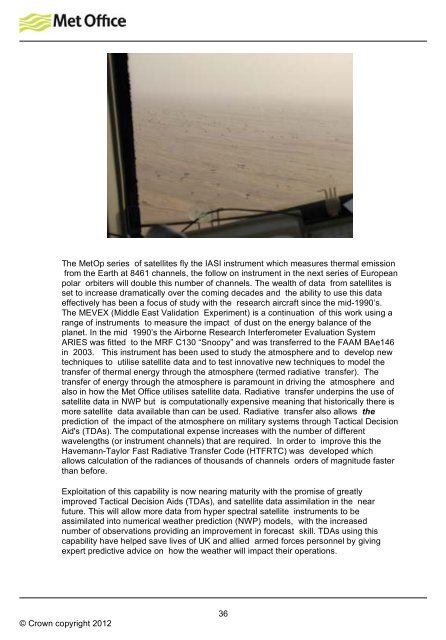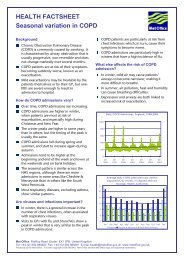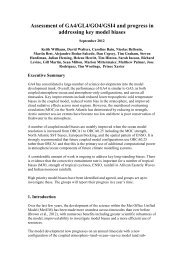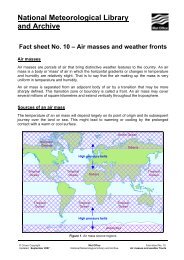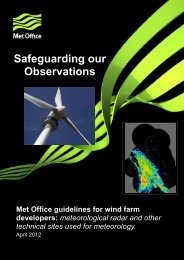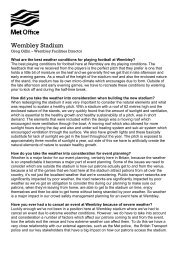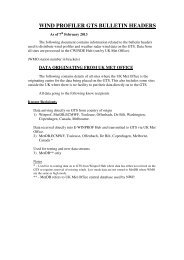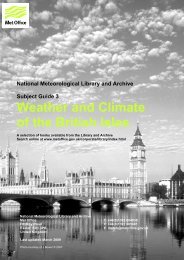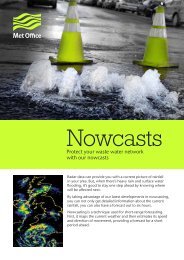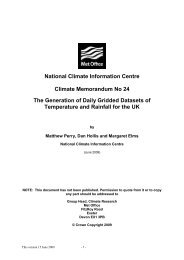70 years of Atmospheric research flying timeline ... - Met Office
70 years of Atmospheric research flying timeline ... - Met Office
70 years of Atmospheric research flying timeline ... - Met Office
- No tags were found...
You also want an ePaper? Increase the reach of your titles
YUMPU automatically turns print PDFs into web optimized ePapers that Google loves.
The <strong>Met</strong>Op series <strong>of</strong> satellites fly the IASI instrument which measures thermal emissionfrom the Earth at 8461 channels, the follow on instrument in the next series <strong>of</strong> Europeanpolar orbiters will double this number <strong>of</strong> channels. The wealth <strong>of</strong> data from satellites isset to increase dramatically over the coming decades and the ability to use this dataeffectively has been a focus <strong>of</strong> study with the <strong>research</strong> aircraft since the mid-1990’s.The MEVEX (Middle East Validation Experiment) is a continuation <strong>of</strong> this work using arange <strong>of</strong> instruments to measure the impact <strong>of</strong> dust on the energy balance <strong>of</strong> theplanet. In the mid 1990’s the Airborne Research Interferometer Evaluation SystemARIES was fitted to the MRF C130 “Snoopy” and was transferred to the FAAM BAe146in 2003. This instrument has been used to study the atmosphere and to develop newtechniques to utilise satellite data and to test innovative new techniques to model thetransfer <strong>of</strong> thermal energy through the atmosphere (termed radiative transfer). Thetransfer <strong>of</strong> energy through the atmosphere is paramount in driving the atmosphere andalso in how the <strong>Met</strong> <strong>Office</strong> utilises satellite data. Radiative transfer underpins the use <strong>of</strong>satellite data in NWP but is computationally expensive meaning that historically there ismore satellite data available than can be used. Radiative transfer also allows theprediction <strong>of</strong> the impact <strong>of</strong> the atmosphere on military systems through Tactical DecisionAid's (TDAs). The computational expense increases with the number <strong>of</strong> differentwavelengths (or instrument channels) that are required. In order to improve this theHavemann-Taylor Fast Radiative Transfer Code (HTFRTC) was developed whichallows calculation <strong>of</strong> the radiances <strong>of</strong> thousands <strong>of</strong> channels orders <strong>of</strong> magnitude fasterthan before.Exploitation <strong>of</strong> this capability is now nearing maturity with the promise <strong>of</strong> greatlyimproved Tactical Decision Aids (TDAs), and satellite data assimilation in the nearfuture. This will allow more data from hyper spectral satellite instruments to beassimilated into numerical weather prediction (NWP) models, with the increasednumber <strong>of</strong> observations providing an improvement in forecast skill. TDAs using thiscapability have helped save lives <strong>of</strong> UK and allied armed forces personnel by givingexpert predictive advice on how the weather will impact their operations.© Crown copyright 201236


